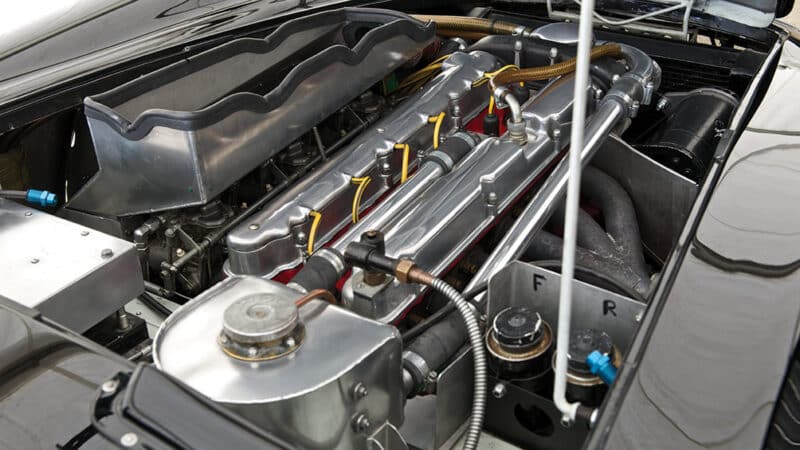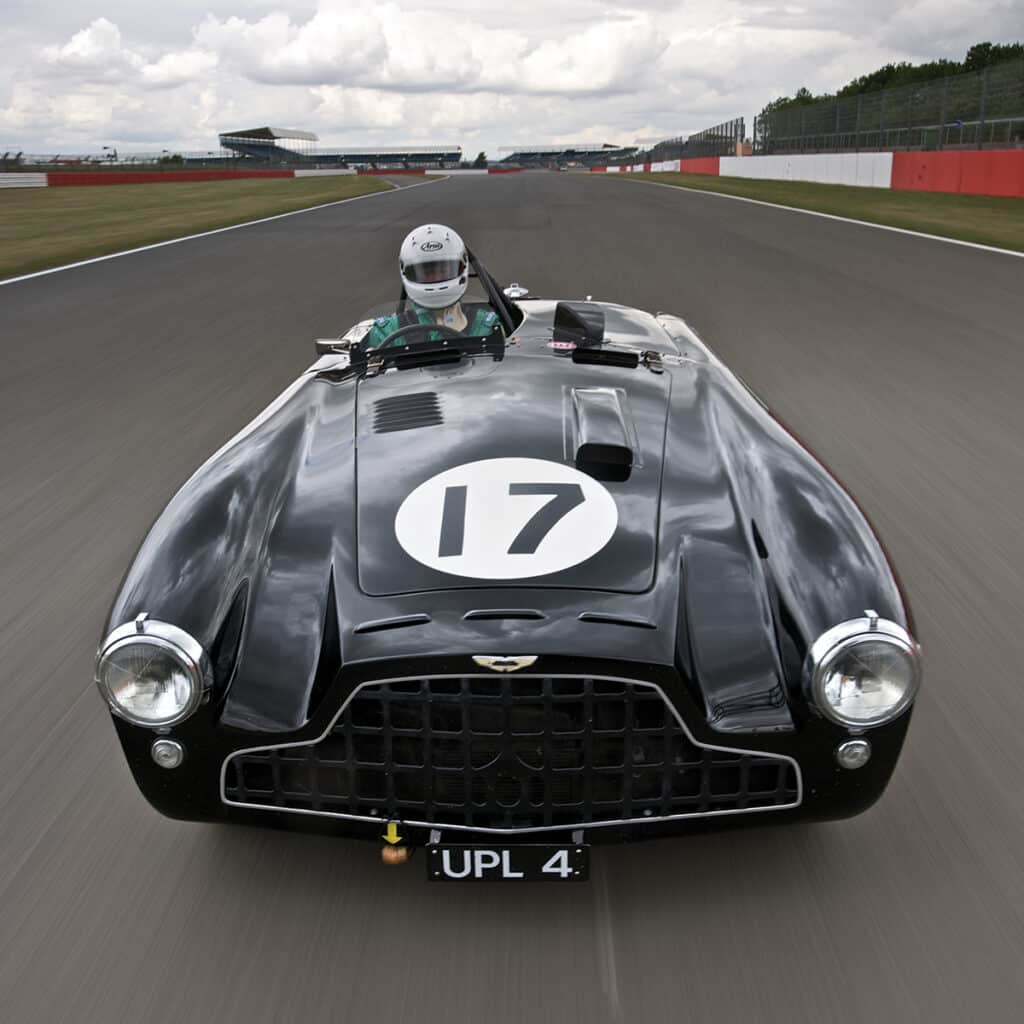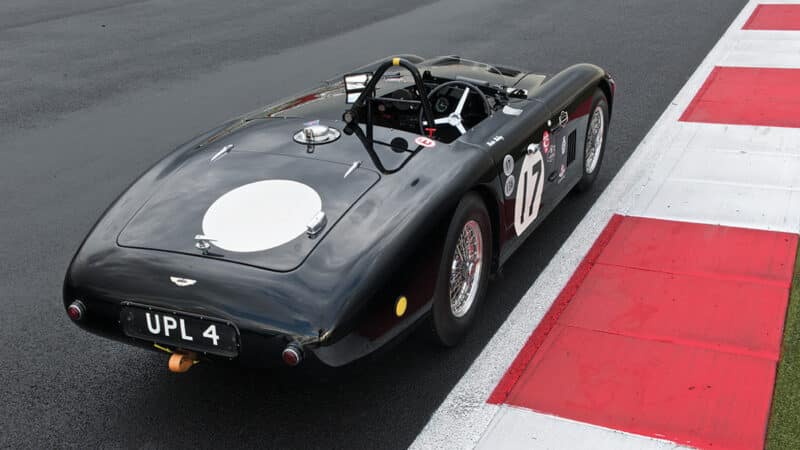From Spa victory to Le Mans struggles: the Aston Martin DB3 story
The DB3, Aston’s first pure-bred racer, was hardly a success story. In its day it lacked grunt, but happily it still knows how to handle a circuit

Stuart Collins
It is fair to say history has not been kind to the Aston Martin DB3. Relative to expectations then, and seen now in the light of what was to follow it, you might even call it a failure. Certainly among the racing David Brown Aston Martins it is perceived as a poor relation. For even if cars like the DBR2, DBR4 and DBR5 were less successful still, they were at least knee-tremblingly beautiful. With the best will in the world, the wide-mouthed DB3 could scarcely even claim that.
But 2011 marks the 60th anniversary of its race debut so perhaps the time is right to revisit the DB3, strip away the benefit of hindsight, assess it on its own merits and, of course, see what it is like for ourselves. For this we are indeed indebted to Martin Melling for allowing us access to the most successful of all the 10 DB3s that were built (five works, five private), and letting me loose in it around the Silverstone Grand Prix circuit.
Debate the success of the DB3 all you like, but you cannot really argue its importance. Not only was it the first Aston to be built from the ground up as a pure racing car, it set off a chain reaction that would lead directly and without interval to Aston Martin winning not only Le Mans, but the world sports car championship eight years later.
The conception of the DB3 itself dates back to 1948. David Brown had bought Aston Martin ‘on a whim’ in 1946, but in terms of possible new product, all it had was the Claude Hill-designed Atom chassis and a rather gutless pushrod 2-litre engine. Against his better judgement he allowed the car that only retrospectively became known as the DB1 to enter the 1948 Spa 24 Hours – which to everyone’s surprise in general, and Brown’s in particular, it promptly went and won.

Straight-six motor now 60bhp up on period; four-speed gearbox is wonderfully precise
Stuart Collins
Bolstered by this success and the arrival of the twin-cam straight-six motor that W O Bentley had designed for Lagonda, Aston Martin installed it under the bonnet of the new DB2 and decided to take its racing a bit more seriously. But Le Mans in 1949 was a disaster, Pierre Marechal becoming to date the only person to lose his life in a works Aston Martin. Even so the pace was clear and the following year the team was back. Now with the steady hand of a certain John Wyer on the rudder they cleaned up: fifth and sixth overall, first and second in the under 3-litre class.
Suitably enthused, Brown asked for an all-new, purpose-built racer for Le Mans in 1951 and commissioned Robert Eberan von Eberhorst, the Viennese who had worked with Professor Porsche on the D-type Auto Unions, to design it. Enter the DB3. Or at least that was the idea.
“It’s the kind of car that leaves you brim-full of confidence after just a couple of laps”
Unsurprisingly, there is more than a whiff of Auto Union about the DB3. Similarly designed around two longitudinal tubular chassis members, it featured trailing arm suspension with a De Dion rear axle located by a Panhard rod, with transverse torsion bar springing fore and aft. Before the day of the disc massive drum brakes were installed, those at the rear located inboard where they would reduce unsprung mass, but also help heat the hypoid drive differential to intolerable levels and introduce Aston to the law of unintended consequences.
Wyer, writing in the late Chris Nixon’s essential Racing with the David Brown Aston Martins, made no secret of the tensions and arguments between the team’s manager and its designer. While Wyer needed a car he could test, Eberhorst was a stickler for detail, procedure and design and went about his work, according to Wyer, ‘at a snail’s pace’. In contrast Eberhorst always laid the blame at the lack of funds made available for the project. After the almost unimaginable amount of money thrown at the Auto Unions before the war, the sums available from a struggling Aston Martin must have indeed seemed inadequate.
Wherever the blame lay, it did not affect the essential truth which was that the DB3 was no more going to make it to Le Mans in 1951 than fly to the moon, so reluctantly the DB2s were sent back to France – and promptly exceeded their previous best and every expectation: three entries, three finishes, the first three places in the class, and third, fifth and seventh overall. If that’s what a race-prepped road car could do, what would a purpose-built racer achieve?

Cockpit has vintage feel
Stuart Collins
Fall flat on its face, that’s what. Only one DB3 was ready to race at the last event of 1951, the TT in Dundrod, from which Lance Macklin was to retire with engine failure.
Look through the results from 1952 and the letter ‘R’ for ‘retired’ stares right back at you with an uncomfortable frequency. The only DB3 entered for the Empire Trophy retired, as did two out of the three that went to compete in the only Monaco Grand Prix to be held for sports cars. Three went to Le Mans and three failed to finish. Three entered the inaugural Goodwood Nine Hours, only one saw the flag.
A disaster, then? Not quite. Good results may have been few and far between, but they were there: at Silverstone the DB3s came second, third and fourth, wrapping up the top three places in the 3-litre class. And while only one did indeed finish at Goodwood, it was in the position that matters, registering the first-ever major victory for a purpose-built Aston Martin racing car.
That car is this car, the fifth of five works cars, DB3/5, which won the Nine Hours with a 20-year-old Peter Collins and Pat Griffith sharing the driving. Nor was that its only moment in the sun: in 1953 it crossed the Atlantic to race at Sebring, coming second overall, missing outright victory by a single lap after 12 hours of racing despite having to stop for lengthy repairs after being crashed by Reg Parnell. Without that, it would undoubtedly have won.
Even so, few and far between though the DB3 successes were, I fear I must pour just a little cold water upon them. For the truth is that Aston Martin must have known even before the DB3 started racing that it was not going to deliver the successes hoped for it. Watching Le Mans in 1951 must have been a glum process for Wyer and his team: for while the DB3 sat on the drawing board, Jaguar’s impossibly sleek and slippery C-type, with its larger and more powerful engine, swept to an utterly convincing victory, putting nine clear laps between itself and the second-placed Talbot-Lago. Wyer would have known already that the DB3’s best chance would be when the Jags either didn’t turn up, or simply broke.
And at Goodwood he got lucky: Collins and Griffith drove faultlessly, but with just three of the nine hours remaining they were still way back in third, watching two far quicker Jaguars seemingly en route to another imperious win. Until they broke. The Aston won, not because it was the fastest, but because it lasted longest.
Not that there is any shame in that: indeed it is the secret of endurance racing. But the bald facts were that the DB3 was too heavy and lacking in power even after the 2.6-litre motor had been expanded to just over 2.9 litres, a task made difficult by the engine’s siamesed cylinder pairings, requiring their bore centres to be moved further apart. Even then, it gave a full half litre and the thick end of 50bhp to the Jaguar motor. Under the circumstances, perhaps the surprise is not that it didn’t do so well, but that it didn’t do a lot worse.
Of course the world moves on and the DB3 has moved with it. Immaculately prepared by Hall & Hall, the motor in DB3/5 now produces around 240bhp, some 60bhp up on what it would have had in its day and more power even than a standard C-type of the era, not that there are too many of those around these days.
Even before you drive it, the DB3 has a vintage feel to it. The cockpit is wide and airy, not small and snug as even sports cars from the middle to the end of the same decade became. The instruments are tiny Smiths dials which are hard to read at a glance and could very easily have come from a pre-war car. You can see why the car was perceived to be simply too conservative in design, right down to the gauge of the metal used, which in the interests of safety Eberhorst had kept thicker and stronger than strictly necessary for racing.

As you acclimatise to the car, you first become aware of its very mechanical feel. The engine’s power delivery is beautifully linear and its four-speed gearbox, if not the fastest, is wonderfully precise. The sense is of Old English heavyweight over-engineering at its finest, as if the influence of W O Bentley had extended beyond the engine bay and into the very fabric of the car.
Drive a little faster, however, and another side of its character emerges, one I was not expecting. Somewhere near race pace, it changes its identity. I wasn’t surprised that it was so fast in a straight line for I have raced against this very Aston many times over the years and know the younger Ferrari 750 Monza I am lucky to drive has only a slight edge over it in a straight line. What I had not expected was for the DB3 to handle so well.
“DB3 has a vintage feel. The sense is of old-english heavyweight over-engineering at its finest”
I’m not sure why I had such preconceptions – perhaps because I knew it was a heavy car and maybe because it just doesn’t look like the most wieldy thing on the grid I had failed to accord it the respect it deserved. What I can tell you now is that it’s the kind of car that leaves you brimful of confidence after just a couple of laps and, in that respect, is the polar opposite of the Ferrari.
It’s one of those cars that makes it clear to you from the very first corner that it’s there to help, and is on your side come what may. It grips surprisingly well and when it does slide, it is never to excess at either end. Well-signalled slip angles develop progressively, leaving you the choice to keep your foot down and ride it out or lift a little to trim your line to suit.
The only part of the car I did not learn to trust was the brakes. There seemed to be precious little complaint about them in period (apart from the ability of those at the rear to overheat the diff) but I never got confident with them or the feel of the pedal, and found myself braking needlessly early just to be on the safe side. I was probably being too gentle on them.
After I’d handed it back and gathered my belongings and thoughts, I headed home and dug out what books I could find to shed some light on the car and its character. And I came across one illuminating nugget of information.
At the Goodwood Nine Hours, the DB3s were up against three works C-type Jaguars. On paper and even around what was then amazingly considered to be only a medium to fast track, the Astons didn’t stand a chance. Yet after the first hour of racing, two of the top three cars were Astons, including the one in the lead.

Looks can deceive: DB3 may not look agile, but proves to have fine handling
Stuart Collins
Had the Astons finally found all that horsepower they lacked? No, rather more simply, it was raining. There is no greater leveller than a wet track and, unable to use their power advantage, the Jaguars fell into the clutches of some clearly rather fine-handling Astons. Only when it dried out did the Jaguars streak off into the lead before finally failing just before the finish to allow the steadily driven DB3/5 through to win.
So does the DB3 deserve its status as the dark star in the Aston Martin firmament? Only if you place an unreasonable burden of expectation on its shoulders. True, it broke more often than it should, but when it finished, it finished well for a car with less than three litres under its bonnet. No, it couldn’t keep up with a well-driven works C-type (in the dry), but given their relative engine sizes it would have been a miracle if it could.
No, I think what’s really done for the way the DB3 is perceived today is the DB3S that followed it. Lighter, more aerodynamic and powerful even before its twin-plug cylinder head had been developed, in its first season it won both the Nine Hours and the TT, achieving more major wins in a fortnight than the DB3 managed in its career. Five years later it was still strong enough to come second at Le Mans for the third time. It was also indescribably gorgeous and capable of making its drivers quite besotted with it.
But none of this was known back in 1952, and as I mentioned at the start, what I have tried to do here is look at the DB3 without being too informed by hindsight and what came next. Do that and you can conclude that in fact the DB3 was far from a disaster, even if you don’t compare it to some of the true turkeys in the Aston racing stable. It was a well-engineered racing car hindered slightly by having to carry too much weight but held back significantly only by the lack of raw power to do justice to the rest of the car. Not so much outmanoeuvred then as outgunned. And there is no shame in that.
